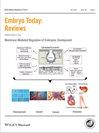Linda M. Reis, Elena V. Semina
下载PDF
{"title":"Conserved genetic pathways associated with microphthalmia, anophthalmia, and coloboma","authors":"Linda M. Reis, Elena V. Semina","doi":"10.1002/bdrc.21097","DOIUrl":null,"url":null,"abstract":"<p>The human eye is a complex organ whose development requires extraordinary coordination of developmental processes. The conservation of ocular developmental steps in vertebrates suggests possible common genetic mechanisms. Genetic diseases involving the eye represent a leading cause of blindness in children and adults. During the last decades, there has been an exponential increase in genetic studies of ocular disorders. In this review, we summarize current success in identification of genes responsible for microphthalmia, anophthalmia, and coloboma (MAC) phenotypes, which are associated with early defects in embryonic eye development. Studies in animal models for the orthologous genes identified overlapping phenotypes for most factors, confirming the conservation of their function in vertebrate development. These animal models allow for further investigation of the mechanisms of MAC, integration of various identified genes into common developmental pathways and finally, provide an avenue for the development and testing of therapeutic interventions. Birth Defects Research (Part C) 105:96–113, 2015. © 2015 Wiley Periodicals, Inc.</p>","PeriodicalId":55352,"journal":{"name":"Birth Defects Research Part C-Embryo Today-Reviews","volume":"105 2","pages":"96-113"},"PeriodicalIF":0.0000,"publicationDate":"2015-06-03","publicationTypes":"Journal Article","fieldsOfStudy":null,"isOpenAccess":false,"openAccessPdf":"https://sci-hub-pdf.com/10.1002/bdrc.21097","citationCount":"60","resultStr":null,"platform":"Semanticscholar","paperid":null,"PeriodicalName":"Birth Defects Research Part C-Embryo Today-Reviews","FirstCategoryId":"1085","ListUrlMain":"https://onlinelibrary.wiley.com/doi/10.1002/bdrc.21097","RegionNum":0,"RegionCategory":null,"ArticlePicture":[],"TitleCN":null,"AbstractTextCN":null,"PMCID":null,"EPubDate":"","PubModel":"","JCR":"Q","JCRName":"Medicine","Score":null,"Total":0}
引用次数: 60
引用
批量引用
Abstract
The human eye is a complex organ whose development requires extraordinary coordination of developmental processes. The conservation of ocular developmental steps in vertebrates suggests possible common genetic mechanisms. Genetic diseases involving the eye represent a leading cause of blindness in children and adults. During the last decades, there has been an exponential increase in genetic studies of ocular disorders. In this review, we summarize current success in identification of genes responsible for microphthalmia, anophthalmia, and coloboma (MAC) phenotypes, which are associated with early defects in embryonic eye development. Studies in animal models for the orthologous genes identified overlapping phenotypes for most factors, confirming the conservation of their function in vertebrate development. These animal models allow for further investigation of the mechanisms of MAC, integration of various identified genes into common developmental pathways and finally, provide an avenue for the development and testing of therapeutic interventions. Birth Defects Research (Part C) 105:96–113, 2015. © 2015 Wiley Periodicals, Inc.
与小眼、眼失和结肠瘤相关的保守遗传途径
人眼是一个复杂的器官,它的发育需要非常协调的发育过程。脊椎动物眼睛发育步骤的保存表明可能存在共同的遗传机制。涉及眼睛的遗传疾病是儿童和成人失明的主要原因。在过去的几十年里,眼部疾病的遗传研究呈指数级增长。在这篇综述中,我们总结了目前在鉴定与胚胎眼发育早期缺陷相关的小眼症、无眼症和结肠瘤(MAC)表型相关的基因方面取得的成功。在动物模型中对同源基因的研究发现了大多数因子的重叠表型,证实了它们在脊椎动物发育中的功能守恒。这些动物模型允许进一步研究MAC的机制,将各种已识别的基因整合到共同的发育途径中,并最终为治疗干预措施的开发和测试提供途径。出生缺陷研究(C辑)105:96-113,2015。©2015 Wiley期刊公司
本文章由计算机程序翻译,如有差异,请以英文原文为准。

 求助内容:
求助内容: 应助结果提醒方式:
应助结果提醒方式:


